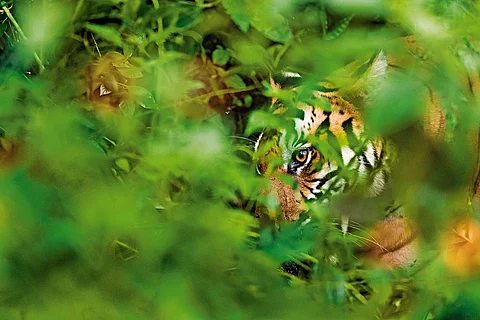
- Destinations
- Experiences
- Stay
- What's new
- Celebrating People
- Responsible Tourism
- CampaignsCampaigns
- Subscribe
- Buy Now

The tiger—bold, watchful, and wild—is as much a creature of legend as of the forest. With its blazing orange coat and inky black stripes, it is often seen as a symbol of strength. In India, its image is revered: in the North, the tiger serves as the mount of the goddess Durga; in the South, it pulls the chariot of Lord Ayyappa. Yet, reverence alone has not protected this apex predator. Its fate remains entangled in a complex web of human-animal conflict, conservation challenges, and habitat degradation.
As forests shrink and human activity encroaches deeper into the wild areas, tigers are increasingly perceived as threats. Retaliatory killings, poaching, and rapid urbanisation have taken their toll. In this fraught landscape, "Sherni" the 2021 film about a tigress navigating both the forest and the bureaucracy that threatens her existence, stirred public discourse about the fragile relationship between humans and wildlife.
But in Karnataka’s BRT Tiger Reserve, a different story unfolds—one of quiet coexistence. Nestled at the ecological crossroads between the Eastern and Western Ghats, this reserve acts as a vital wildlife corridor, supporting gene flow across species between the mountain ranges. Amidst this biodiversity, the Soliga community—among the few Indigenous groups in India legally residing in a tiger reserve—has lived for generations, guided by tradition, spirituality, and ecological wisdom preserved in folk songs such as the Haduke, which are sung from dusk till dawn and honour the tiger as a divine guardian and the forest as sacred.
“We’re not doing anything extraordinary. We let the tigers be, and they let us be,” said Dr C. Madegowda, a Soliga research associate at the Ashoka Trust for Research in Ecology and the Environment (ATREE), Bengaluru.
The Biligirirangana Hills, now a designated tiger reserve, were once at the centre of a struggle for Indigenous rights. Following the enforcement of the Wildlife (Protection) Act of 1972, the Soligas faced eviction from their ancestral land. It wasn’t until the enactment of the Forest Rights Act in 2006 that they regained the legal right to reside in the forest. Today, around 33,000 Soligas (according to the 2011 Census) continue to live here, practising small-scale agriculture, foraging, and performing spiritual rituals rooted in the land. To them, the forest is sacred, and its animals are not mere inhabitants—they are deities, protectors, and kin.
“Tigers and elephants are revered,” Madegowda explained. “Each clan has an animal it worships. Through rituals, we look after their welfare.” Meanwhile, Samira Agnihotri, Associate Professor of Coexistence Studies at the University of Trans-Disciplinary Health Sciences and Technology, who has worked closely with the community, added, “The Soligas worship the tiger as Huli Veerappa, a forest deity and the vehicle of Lord Madeshwara. They see it not as a threat, but a guardian.”
This belief system has helped create an environment of mutual respect. For the Soligas, conservation is not a campaign—it is a way of life.
Conflict, however, is not absent. Tigers, by nature, are territorial. Attacks, while rare, do occur. But the Soligas have long-developed ways of reducing risk—methods that are cultural, spiritual, and ecological. “Harming a tiger is equivalent to dishonouring our deity,” said Madegowda. “So we do everything to avoid confrontation.”
Some methods are surprisingly subtle. For instance, when spotting a tiger, Soligas refer to it as Dodda Nayi (big dog) a phrase believed to shame the tiger into retreat. Others rely on natural deterrents. Burning dried honeycombs produces a pungent smoke that discourages tigers from approaching homes without harming the animal. Sometimes, they even leave behind honey-laced combs for the tiger as a peace offering.
“We hope that by offering them food, they’ll see us not as threats but as friends,” Madegowda added.
Despite their centuries-old relationship with the forest, the Soligas now face new challenges. As of March 2025, the BRT Tiger Reserve recorded 39 tigers—down from 45 in previous years. Officials have said the decline is not yet alarming, but the warning signs are there. Unregulated tourism is encroaching into sensitive habitats. The spread of Lantana camara L., an invasive shrub, is degrading grasslands vital for herbivores—the tiger’s primary prey.
“The loss of grasslands leads to fewer herbivores, which in turn affects tiger survival,” explained Madegowda.
A more subtle threat is cultural erosion. Smartphones and modern education are pulling younger generations away from traditional practices. Yet there is hope: many young Soligas now work with forest departments as watchers or in anti-poaching units, applying their inherited knowledge to modern conservation efforts.
Still, restricted access to forest areas has created a sense of displacement. “We have always been the custodians of this land,” said Madegowda. “When we are cut-off from it, both Soligas and the forest suffer.”
The story of the Soligas is not just one of survival but of stewardship. Their spiritual beliefs, lived experiences, and time-honoured practices have created a model of conservation that is both effective and deeply human. In a world where wildlife and indigenous rights are often seen in opposition, the Soligas offer an alternative vision—one where coexistence isn’t a policy, but a mutual understanding.
As long as the Soligas walk these forests, the tiger will be more than a symbol. It will be a neighbour. A guardian. A god.
